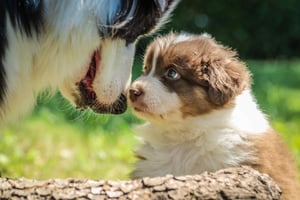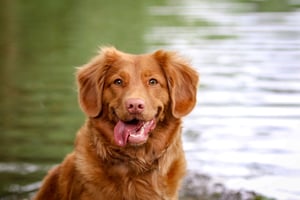Walks with our four-legged friends are meant to be enjoyable. After all, exercise is important for...
What to Do If Your Dog Pulls On The Leash?
Stopping your dog from pulling on leash, or loose lead walking is essentially training your dog to walk by your side without pulling the lead.
To teach your dog Loose Lead Walking you need to start with something very different - eye contact.
Eye Contact is simply the idea that to get what they want, your dog looks to you first.
Without a doubt, this is the one exercise that makes all other exercises easier. It is the spine of everything.
Think about it: if your dog’s not looking at you, there’s a pretty good chance that they're not listening to you either! The added benefit is that Eye Contact stops them from doing other unwanted behaviours – for example, your dog can't pull on their lead if they are looking up at you.
How do I get my dog to stop pulling on the leash? (Day-by-day plan)
Day 1
To teach your dog Loose Lead Walking you need to start with something very different - eye contact. Eye Contact is simply the idea that to get what they want, your dog looks to you first. Without a doubt, this is the one exercise that makes all other exercises easier. It is the spine of everything.
Start off in a low distraction environment and, with your dog on the lead. Drop 5-6 treats, one at a time, around your dog, so they get to anticipate that the next dropped treat is only moments away.
When your dog finishes the treats and you see signs of that anticipation of another treat, don't drop another treat, wait….
Say to your dog “Oi! Where’s my treat!”. As soon as they look up to you, say "GOOD", and drop another treat.
When they look up at you again, say "GOOD", and drop another treat.
Again, wait. When they look up at you, say "GOOD" and drop another treat. Now we have the foundation that Eye Contact equals rewardment.
Day 2
Today will be doing the same exercise as yesterday, but we're going to add an extra step.
Start off in a low distraction environment and, with your dog on the lead. Drop 5-6 treats, one at a time, around your dog, so they get to anticipate that the next dropped treat is only moments away.
Wait until your dog looks up to you as if to say “Oi! Where’s my treat!” as soon as they look up to you, say "GOOD", and drop another treat from them.
Again, wait, only say "GOOD" and drop another treat. When they again look up to you.
Wait, only say "GOOD" and drop another treat. When they again look up to you.
The idea behind this exercise is to make your dog understand that to get what they want, they need to look at you first. This would make a big difference when we move to the actual loose lead qalking practice.
Day 3
We hope that your training yesterday was pawesome... sorry awesome! Today we'll be working on your dog's focus to prepare them for the loose lead walking.
Crouch down next to your dog while they are on a lead, with a treat in your hand. Hold your arm out to your side.
Let your dog sniff, lick, even paw your hand, but do nothing and say nothing.
Wait until your dog looks at your face then say "GOOD" (to mark the behaviour) and give them the treat.
Go back to the start with a treat out to the side in your hand, then repeat, repeat, repeat.
Day 4
Once you have built a super-strong level of Eye Contact, it’s time to take things up a level – let us introduce you to ‘The 3D’s’ - namely, Duration, Distraction and Distance. We add these three elements to really reward and make this behaviour water-tight.
So here, you need to start to alter the duration between the dog looking at your face and you saying "GOOD" (and giving a treat). First delay for one second, then two … etc
Try getting to 10-15 seconds and keep practising with your dog.
When you are happy that it is rock solid, you look to change the distractions – in this case, you shake your hand out to the side; once that is mastered, you try putting the treat in your other hand, then after that use two hands each outstretched.
Get access to the rest of the course (and videos) in the Fluffy app. It's free!
How to stop a dog from pulling when seeing another dog?
The first thing to remember is that whenever our dogs try to pull us forward we try to pull them back. This is wrong. Dogs have an opposition reflex - when you pull them one way, they pull the other. There are multiple reasons your dog might be pulling on a leash when around another dog.
It can be because they feel vulnerable as they can't escape. It can be due to the fact that the collar causes discomfort on their walks and they associate it with other dogs, so the more they pull when they see other dogs, the more it hurts, and the more they pull again.
You need to check the dog behaviours that you want them to follow when they see other dogs. When they see another dog, try creating some distance. Then get your dog excited with treats and keep doing until your dog learns that when there is another dog nearby they need to sit next to you and ask for a treat. It will keep them calm and create a better environment.
Can you hurt your dog by pulling on the leash?
The short answer is yes. It can cause Bruises & Cuts, Chocking and Hypothyroidism
Pulling on a leash can cause health problems for your dog. That's why it is so important to spend time teaching loose leash walking. Here're the most coming problems that arise when your dog is pulling on leash:
Bruises & Cuts
When your dog is pulling on leash it can cause cuts and bruises. Because dogs react to pain differently than humans we often don't know notice when they're in pain. Moreover, their necks are similar to ours, so they can easily injure them.
Chocking
If your dog is panicking or too excited they might not know that they need to stop pulling. They try to get themselves free by putting pressure on their neck which can stop the airflow.
Hypothyroidism (Decrease in Thyroid Gland Hormone)
Like humans, dogs have their thyroid glands in their necks. This means that any injuries to the neck might have a negative impact on the thyroid gland.



